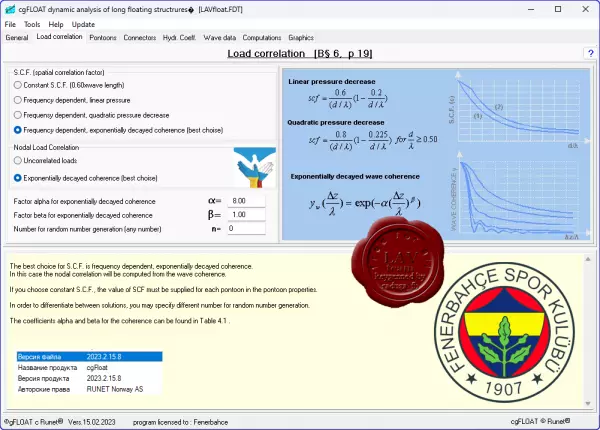RUNET software cgFLOAT version 15.02/2023
Floating marinas, floating breakwaters and floating bridges are long structures made up of pontoons which are connected between them rigidly or with flexible connectors, and they are anchored at the bottom of the sea with mooring lines.
They are usually placed in protected water regions.
The waves in these regions are short crested waves.
The dynamic analysis of long floating structures in short crested waves must take into account the special characteristics of the short crested wave loading, and the frequency depended load correlation along the structure.

The structural modelling using finite element methods does not present any difficulties.
However the part of the analysis which presents special problems is the modelling of the loading in a short-crested sea.
General purpose finite element programs do not provide methods for calculating the loading in a stochastic, short crested sea, and additional routines should be included in order to do the job.
In conclusion the use of general purpose finite element programs is - time consuming, uneconomic, and susceptible to errors.
The program cgFLOAT has been developed especially for long floating structures in short crested sea loading.
The dynamic response can be calculated via a frequency or time domain analysis.
Theories and methods for hydrodynamic loading, short-crested waves, directional wave spectra, sea state simulation, and stochastic dynamics are included in the calculation routines.
The computer code has been optimized taking into account the special characteristics of the structure and the loading.
For the response calculation a Monte-Carlo simulation is used.
This method is considered to be more advantageous over the usual frequency domain analysis, which is the only alternative, because it reduces the computational cost considerably and can be used for frequency and time domain analysis.
It is based in simulating sets of nodal load series and calculates the structural response by deterministic dynamic analysis in frequency or time domain.
The expected response values are obtained in the end by calculating the ensemble statistics between the simulated cases.
The basis for computing the sets of nodal load series is the wave coherence along the structure, which is obtained from the directional wave spectrum.
Size: 15.3 MB
Download
*
Floating marinas, floating breakwaters and floating bridges are long structures made up of pontoons which are connected between them rigidly or with flexible connectors, and they are anchored at the bottom of the sea with mooring lines.
They are usually placed in protected water regions.
The waves in these regions are short crested waves.
The dynamic analysis of long floating structures in short crested waves must take into account the special characteristics of the short crested wave loading, and the frequency depended load correlation along the structure.

The structural modelling using finite element methods does not present any difficulties.
However the part of the analysis which presents special problems is the modelling of the loading in a short-crested sea.
General purpose finite element programs do not provide methods for calculating the loading in a stochastic, short crested sea, and additional routines should be included in order to do the job.
In conclusion the use of general purpose finite element programs is - time consuming, uneconomic, and susceptible to errors.
The program cgFLOAT has been developed especially for long floating structures in short crested sea loading.
The dynamic response can be calculated via a frequency or time domain analysis.
Theories and methods for hydrodynamic loading, short-crested waves, directional wave spectra, sea state simulation, and stochastic dynamics are included in the calculation routines.
The computer code has been optimized taking into account the special characteristics of the structure and the loading.
For the response calculation a Monte-Carlo simulation is used.
This method is considered to be more advantageous over the usual frequency domain analysis, which is the only alternative, because it reduces the computational cost considerably and can be used for frequency and time domain analysis.
It is based in simulating sets of nodal load series and calculates the structural response by deterministic dynamic analysis in frequency or time domain.
The expected response values are obtained in the end by calculating the ensemble statistics between the simulated cases.
The basis for computing the sets of nodal load series is the wave coherence along the structure, which is obtained from the directional wave spectrum.
Size: 15.3 MB
Download
*
